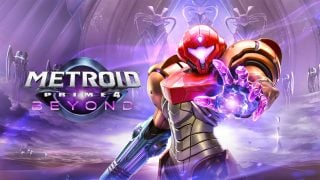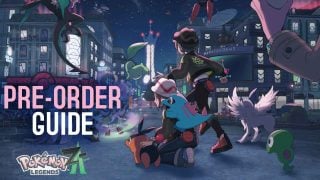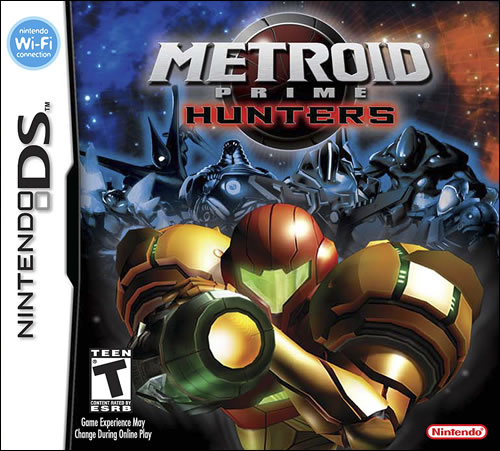Often considered the third series in Nintendo’s holy trinity, Metroid has been around for just as long as Mario’s been crashing the wrong castle in search of distressed damsels or Link’s refusal to go it alone. Yet despite this legendary designation, the galactic adventures of bounty hunter Samus Aran rarely get quite as much love and attention from the big N as they deserve. So strap on your Plasma Beams and power up those Varia Suits because this past week, we here at Nintendo Wire have enjoyed a trip down memory lane through Metroid’s extensive 30-year history, exploring what makes the series such an influential legend in the gaming industry — not to mention one of my favorite gaming franchises of all time.
Metroid Prime Hunters (Nintendo DS)
Download on [Wii U]
Unlike its portable predecessors, Metroid’s next handheld installment wouldn’t be in 2D, but would instead adopt the first-person shooter perspective made famous by the Prime series. Initially packaged as a demo during the launch of the Nintendo DS back in 2004, the full version of Hunters released to critical acclaim much later in 2006. Despite the game’s moniker, it’s worth noting that Hunters was not developed by Retro Studios, but instead by Nintendo’s Redmond-based subsidiary Nintendo Software Technology. As a result, the game contained more first-person shooter-heavy aspects than both Prime and Echoes, along with the removal of assisted aiming, more action-oriented gameplay and a hefty focus on its multiplayer mode.
Set between the events of the first two Metroid Prime games, Samus is sent on a mission by the Galactic Federation to investigate and retrieve the “ultimate power” residing in various artifacts scattered across the Alimbic star system by a long extinct race of warriors. A series first and a welcome twist to the Metroid formula, Samus was joined by six rival bounty hunters all competing to collect these artifacts and gain the “ultimate power” for themselves. Best of all, each bounty hunter came with their own weapons, special abilities and style that perfectly suited their personalities. Should you at any point lose to a rival hunter, they’d take off with all your collected Octoliths, forcing the you to track them down and reclaim your stolen goods.
Hunters is perhaps most notable for pushing the DS to its maximum potential both graphically and through innovative use of the touch screen, easily establishing it as one of the best handheld first-person shooter experiences produced for the dual-screened system. Aiming was completely delegated to the touchscreen and stylus, and while a little cumbersome to get used to at first, the amount of precision this gave players was unprecedented.
Most impressive was the game’s solid multiplayer mode: a significant improvement over Echoes’s more lighthearted first attempt. Featuring both online and local play, seven modes, 26 arenas and enough weapon variety to satisfy the most hardcore of shooter fans, this clearly wasn’t just some half-baked afterthought. Matches were fluid, gameplay was tight and winning matches required immense skill and strategy from the player. In terms of features, Hunters’s multiplayer even manages to outperform some of Nintendo’s more recent online multiplayer games, sporting both voice chat and a touch screen keyboard for talking with friends while in the lobby (I’m looking at you, Splatoon). Unfortunately, Hunters’s online multiplayer mode is nothing more than a distant memory these days due to the servers being shut down years ago. The Wii U Virtual Console port is also sadly a no-go, being completely stripped of its multiplayer components. Nonetheless, if you can still find a few friends with physical copies of the game, I highly recommend giving it a try.
Fun fact: Metroid Prime Hunters is the only game in the series that doesn’t feature Metroids, though early demos of the game showcased them in all their brain sucking glory.
Metroid: Other M (Wii)
Purchase on [Amazon]
A collaborative effort between Team Ninja and series co-creator Yoshio Sakamoto, Other M was a much more narratively-driven experience compared to its predecessors. Hot off the heels of the events of Super Metroid, the game begins with a distraught Samus reminiscing about her previous mission, particularly her confrontation with the mechanical monstrosity Mother Brain and the selfless sacrifice of the Metroid larva back on planet Zebes. A distress signal from a decommissioned vessel known as the “Bottle Ship” catches Samus’s attention, where she encounters the Galactic Federation 07th Platoon led by her former commanding officer, Adam Malkovich. Together they explore the mysteries of the abandoned ship, ultimately discovering its true purpose: conducting research on bioweapons using the DNA of — you guessed it — Metroids.
The black sheep of the family, Other M is, universally, the most hated game in the Metroid franchise — and not without good reason. Most of Other M’s criticism focused on its overdrawn, melodramatic story and poor depiction of Samus’s character and personality. The overabundance of story coupled with its lengthy, unskippable cutscenes (while gorgeously rendered) significantly hindered the excellent pacing the series is known for. The plot itself wasn’t particularly compelling either, coming off as bland, boring and completely cliche at times. Worst of all, though, was Samus’s depiction as a relatively immature, petulant child: personality traits in stark contrast to the strong, fearless heroine fans grew to love over her many years kicking Space Pirate butt without missing a beat. Sakamoto even admitted that prior to Other M’s development, not much thought went into Samus’s personality in order to give her character an intended air of mystery. So why mess with it, you ask? The decision to depict her weaker, more vulnerable side was largely an effort to help players form a stronger, more emotional bond with Samus: a bold move that ultimately proved unsuccessful, marred further by questionable voice acting and poor writing.
All things considered, there’s a fairly decent game hidden beneath its admittedly nonsensical narrative. Albeit much more linear than Metroid Fusion, Other M keeps enough of the series’s sense of exploration intact while placing a much greater emphasis on combat. Designed with controls that mimic the simplicity of an NES game, players control Samus on a 2-D plane, though they can switch to a first-person perspective on the fly by pointing the Wii Remote at their television screens. Shifting seamlessly between two-dimensional platforming and precision shooting in a three-dimensional space created unique opportunities for intriguing puzzle solving and some truly epic and memorable boss bottles that its predecessors could only dream of. Despite its shortcomings, I personally found it to be a tad over-abused by fans, and would still urge fans of the series to give it a second playthrough under a more forgiving lens.
Fun fact: Yoshio Sakamoto opted to work with an outside company during the game’s production because his development team didn’t have the technical chops to create his vision for the game. He eventually approached Yosuke Hayashi of Team Ninja to discuss the incorporation of the Ninja Gaiden engine to bring his concept of a 3-D Metroid game to life.
That’s a wrap!
I hope you enjoyed reading this (admittedly) lengthy exploration on the endless expanses of the Metroidverse as much as I did writing it. Near and dear to my heart, it’s a lovingly crafted series that deserves to be in the spotlight just as much as Mario, Zelda or Pokémon. As for what’s next? A new entry for Wii U at this point seems highly unlikely, so my money is firmly planted on an early NX release. (Hey, a guy can dream.) Hopefully, we won’t have to wait too long for Samus’s next solo outing, though at least there’s the upcoming multiplayer-based and Monster Hunter-inspired spinoff Metroid Prime: Federation Force to look forward to later this month.
Happy Birthday, Samus!
Nintendo Wire honored Metroid’s 30th anniversary by hosting a series of celebratory articles commemorating the franchise’s rich history and influential impact on the action-adventure genre. Make the Galactic Federation proud and be sure to check out our previous entries to gain a better understanding of what makes Samus and her bounty hunting adventures such memorable masterpieces:
Metroid Memories, Part I — Metroid & Metroid II: Return of Samus
Metroid Memories, Part II — Super Metroid & Metroid Fusion
Metroid Memories, Part III — Metroid Prime trilogy
Metroid Memories, Part IV — Metroid: Zero Mission & Metroid Prime Pinball




